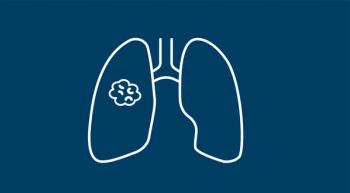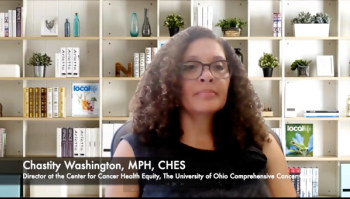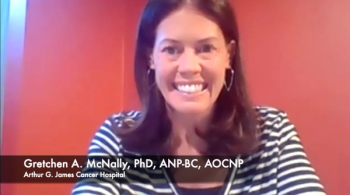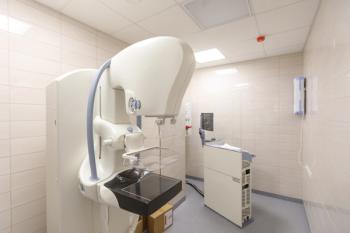
The use of pirtobrutinib following covalent Bruton tyrosine kinase inhibitor therapy may be an important sequencing approach in chronic lymphocytic leukemia/small lymphocytic lymphoma, according to recent research.

The use of pirtobrutinib following covalent Bruton tyrosine kinase inhibitor therapy may be an important sequencing approach in chronic lymphocytic leukemia/small lymphocytic lymphoma, according to recent research.

Frontline chemoimmunotherapy was associated with improved median overall survival, compared with chemotherapy alone, in patients with advanced non–small cell lung cancer.

Heather Niccum Haag, BSN, RN, CCRN, shares how her institution improved patient education with the treatment belzutifan.

Heather Niccum Haag, BSN, RN, CCRN, shares her experience creating an educational resource for her patients with Von-Hippel Lindau tumors who are receiving belzutifan.

Managing ocular-related adverse effects with mirvetuximab soravtansine is key to helping patients with ovarian cancer stay on treatment.

Oncology nurse experts review their experiences with newcomers for the treatment of advanced endometrial cancer and exchange best practices in caring for this population.

Courtney R. Arn, APRN-CNP, discusses the recent approval of dostarlimab for patients with mismatch repair–deficient recurrent or advanced endometrial cancer.

Patients with acute lymphoblastic leukemia who received vincristine-based regimens with TKIs did not experience more chemotherapy-induced peripheral neuropathy vs those who did not.

Gretchen McNally, PhD, ANP-BC, AOCNP, discusses the rationale behind a pilot study which will assess patient reported outcomes for patients with lymphoma who develop chemotherapy-induced peripheral lymphoma.

Gretchen McNally PhD, ANP-BC, AOCN, spotlights the value that naloxone training for oncology nurses and providers could have for patients who are at a high-risk of overdose.

Gretchen McNally PhD, ANP-BC, AOCNP, discusses the potential impact advanced practice providers and nurses could have in the opioid pandemic if the correct educational opportunities were available.

A real-world analysis showed that the proportion of women with ovarian cancer who required dose modifications or treatment discontinuations while receiving PARP inhibitors differed significantly between olaparib, niraparib, and rucaparib.

Oncology nurses may be able decrease peripheral access wait times for patients, however, a change in culture may be necessary to see full results.

Inclusion has to be an intentional part of the plan as strategies to diversify the nursing field are adopted.

Courtney Arn, APRN-CNP, a nurse practitioner comments on the recent approval of pembrolizumab for patients with MSI-H/dMMR advanced endometrial carcinoma.

Courtney Arn, APRN-CNP, a nurse practitioner who supported cohorts D and K of the KEYNOTE-158 study, discusses the recent approval of pembrolizumab for patients with MSI-H/dMMR advanced endometrial carcinoma.

The general population experienced nearly double the amount of anxiety and depression that patients with non–small cell lung cancer reported during the COVID-19 pandemic.

An expert from the Ohio State University Comprehensive Cancer Center discusses whether predictive biomarkers hold the potential to change endometrial prognoses.

Kathy Burns, MS, APRN-CNS, AGCNS-BC, of the Arthur G. James Cancer Hospital and Richard J. Solove Research Institute, comments on the importance of self-awareness as an oncology nurse when working to overcome one’s implicit bias.

Kathy Burns, MS, APRN-CNS, AGCNS-BC, Arthur G. James Cancer Hospital and Richard J. Solove Research Institute, comments on the importance of being mindful about one’s implicit bias in the treatment of patients with cancer who have substance use disorders.

The director at the Center for Cancer Health Equity, The University of Ohio Comprehensive Cancer Center, discusses how the pandemic put a spotlight on issues of equity within the health care system.

A survey completed by nurses and APPs revealed that many healthcare professionals may be blind to their own implicit biases.

“It is not a ‘one and done kind of thing.” It is very important to implement these skills throughout the community. It's a practice. It's a behavioral change.”

The director at the Center for Cancer Health Equity, The University of Ohio Comprehensive Cancer Center, discusses improving preventative screenings in underprivileged communities.

A speaker at the Oncology Nursing Society Bridge Program discussed how nurses can build their own resilience and proactively protect their mental well-being.

Answering questions without judgement and showcasing community members who have received the COVID-19 vaccine without negative outcomes can help alleiviate vaccine-related fears and concerns in BIPOC patients with cancer.

New research suggests that fertility-sparing surgery is feasible and safe in treating ovarian malignant germ cell tumors.

A phase 2 trial presented at the 2021 ESMO Annual Congress showed that Balstilimab plus Zalifrelimab induced superior response rates, duration of responses, and overall survival in patients with recurrent/metastatic cervical cancer.

“We’ve had periods of time where things were shut down. We do have telemedicine, that was expanded, but telemedicine doesn’t work for everyone. If you don’t have internet access, if you don’t have the ability to understand the technology….”

“There were delays in getting preventative screenings, there were delay in diagnostics, there was also a brief period of time when some of the clinical trials were shut down.”